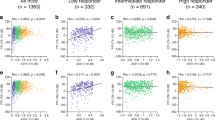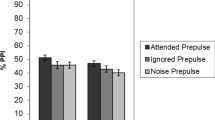The characteristics of prepulse inhibition (PPI) and prepulse facilitation (PPF)of the acoustic startle reaction (ASR) were studied in healthy subjects and patients with schizophrenia. Testing was performed in accordance with the recommendations of the International Schizophrenia Genetics Consortium. Patients showed a deficit in PPI with a prepulse interval of 60 msec and suppression of PPF with an interval of 2500 msec, demonstrating impairments of undirected attention. Differences were seen in the effects of histories of craniocerebral trauma and experience of consumption of psychoactive substances on PPI and PPF in healthy subjects and patients. Correlations between baseline ASR and increases in excitement (PANSS scale P4) and between impairments to PPF and the severity of positive symptomatology were seen. The results obtained here provide evidence that the prepulse ASR modification test can be used in clinical neurophysiology.
Similar content being viewed by others
References
S. N. Mosolov, Scales for the Psychometric Assessment of the Symptomatology of Schizophrenia and the Concept of Positive and Negative Disorders [in Russian], Novyi Svet (2001).
M. E. Dawson, A. M. Schell, N. R. Sverdlov, et al., Attention and Orienting. Sensory and Motivational Processes, Erlbaum, Hillsdale, NJ (1997).
M. Escobar, P. Oberling, and R. R. Miller, “Associative deficit accounts of disrupted latent inhibition and blocking in schizophrenia,” Neurosci. Biobehav. Rev., 26, No. 2, 203–216 (2002).
G. Gal, Y. Barnea, L. Biran, et al., “Enhancement of latent inhibition in patients with chronic schizophrenia,” Behav. Brain Res., 197, No. 1, 1–8 (2009).
M. A. Geyer, K. Krebs-Thomson, D. L. Braff, and N. R. Swerdlow, “Pharmacological studies of prepulse inhibition models of sensorimotor gating deficits in schizophrenia: a decade in reivew,” Psychopharmacology (Berlin), 156, 117–154 (2001).
A. Gironell, A. Rodríguez, J. Kulisevsky, et al., “Abnormalities of the acoustic startle reflex and reaction time in Gilles de la Tourette syndrome,” Clin. Neurophysiol., 111, No. 8, 1366–1371 (2000).
T. A. Greenwood, D. L. Braff, G. A. Light, et al., “Initial heritability analyses of endophenotypic measures for schizophrenia: the Consortium on the Genetics of Schizophrenia,” Arch. Gen. Psychiat., 64, No. 11, 1242–1250 (2007).
W. Hasenkamp, S. D. Norrholm, A. Green, et al., “Differences in startle reflex and prepulse inhibition in European-Americans and African-Americans,” Psychophysiology, 45, No. 5, 876–882 (2008).
L. E. Hong, I. Wonodi, J. Lewis, and G. K. Thaker, “Nicotine effect on prepulse inhibition and prepulse facilitation in schizophrenia patients,” Neuropsychopharmacology, 33, No. 9, 2167–2174 (2008).
V. Kumari, E. Antonova, M. A. Geyer, et al., “A fMRI investigation of startle gating deficits in schizophrenia patients treated with typical or atypical antipsychotics,” Int. J. Neuropsychophamacol., 10, No. 4, 463–477 (2007).
A. Minassian, D. Feifel, and W. Perry, “The relationship between sensorimotor gating and clinical improvement in acutely ill schizophrenic patients,” Schizophr. Res., 89, No. 1–3, 225–231 (2007).
W. Perry, M. A. Geyer, and D. L. Braff, “Sensorimotor gating and thought disturbance measured in close temporal proximity in schizophrenic patients,” Arch. Gen. Psychiatry, 56, 277–281 (1999).
N. R. Swerdlow, G. A. Light, K. S. Cadenhead, et al., “Startle gating deficits in a large cohort of patients with schizophrenia: relationship to medications, symptoms, neurocognition, and level of function,” Arch. Gen. Psychiatry, 63, No. 12, 1325–1335 (2006).
N. R. Swerdlow, J. Sprock, G. A. Light, et al., “Multi-site studies of acoustic startle and prepulse inhibition in humans: initial experience and methodological considerations based on studies by the Consortium on the Genetics of Schizophrenia,” Schizophr. Res., 92, No. 1–3, 237–251 (2007).
J. van Os, B. P. Rutten, and R. Poulton, “Gene-environment interactions in schizophrenia: review of epidemiological findings and future directions,” Schizophr. Bull., 34, No. 6, 1066–1082 (2008).
F. X. Vollenweider, P. A. Csomor, B. Knapp, et al., “The effects of the preferential 5-HT2A agonist psilocybin on prepulse inhibition of startle in healthy human volunteers depend on interstimulus interval,” Neuropsychopharmacology, 32, 1876–1887 (2007).
Author information
Authors and Affiliations
Corresponding author
Additional information
Translated from Zhurnal Nevrologii i Psikhiatrii imeni S. S. Korsakova, Vol. 111, No. 2, pp. 72–75, February, 2011.
Rights and permissions
About this article
Cite this article
Storozheva, Z.I., Kirenskaya, A.V., Lazarev, I.E. et al. Prepulse Modification of the Acoustic Startle Reaction in Healthy Subjects and Patients with Schizophrenia. Neurosci Behav Physi 42, 128–132 (2012). https://doi.org/10.1007/s11055-011-9545-z
Published:
Issue Date:
DOI: https://doi.org/10.1007/s11055-011-9545-z




